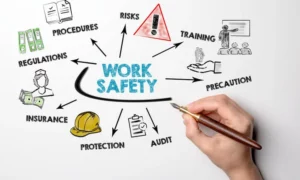When it comes to workplace safety in Australia, having a robust emergency evacuation plan is absolutely essential. Whether your company employs five people or 500 people, you must ensure that your employees have access to appropriate and effective emergency evacuation procedures for any unexpected event – from fire or floods to hazardous chemical spills.
In this post, we’ll be discussing the importance of such planning and outline some key considerations when creating an evacuation plan for your workplace. So if you’re looking to ensure the safety of your staff and customers, then keep on reading!
Legal And Regulatory Requirements For Emergency Evacuation Planning
Emergency evacuation is a mandatory safety requirement in practically every business workplace, and emergency evacuation plans are essential for everyone’s safety. Legal and regulatory requirements need to be taken into consideration when formulating these emergency plans to ensure their efficiency in the event of an emergency.
Making sure the plan address fire alarms, emergency exits, emergency equipment maintenance, emergency personnel, and–depending on the project or the workplace–other important considerations such as hazardous materials are all key components in creating an emergency evacuation plan that will meet all legal and regulatory standards. These plans can save time, resources and possibly lives by providing well-thought-out solutions for emergency situations.
Conducting A Workplace Emergency Risk Assessment
It is important for the safety of employees in any given workplace that emergency risk assessments are conducted. Such an assessment seeks to identify and prioritize risks, as well as provide clear prevention and evacuation strategies. During an emergency risk assessment process, certain elements must be considered, such as equipment maintenance, health and safety regulations, emergency evacuation training, and hazard identification.
An effective emergency evacuation plan should include emergency drills where workers learn how to make a safe exit during an emergency event. It is also important to hold regular communication sessions with stakeholders in order to assess existing precautions, discuss any changes in hazardous conditions or environments and review existing emergency evacuation plans.
Employee Training And Education On Emergency Evacuation Planning And Procedures
Emergency evacuations occur in the workplace due to many factors such as natural disasters, hazardous materials, and fire hazards. To implement an effective employee evacuation plan, organizations must provide their employees with appropriate emergency evacuation training and education. This process involves teaching staff members the necessary steps to take during an emergency evacuation situation, as well as preparing them for any challenges they may face while evacuating the workplace.
Additionally, organizations should create detailed documents outlining their emergency evacuation policy and procedures that all employees can easily access. With proper training and education, personnel will be better prepared to respond quickly and safely in an emergency evacuation scenario.
Testing And Evaluating Emergency Evacuation Procedures
Proper emergency evacuation procedures are essential for almost every type of organization. One of the most important ways to ensure that emergency evacuation plans are effective is to regularly test and evaluate them. This involves regularly simulating emergency scenarios and determining how effective the emergency evacuation plan was in responding to the emergency.
Through this regular testing and evaluation process, organizations can make sure their emergency evacuation plans remain up-to-date and meet the needs of everyone who may be involved in an emergency evacuation situation, including employees, customers, or other visitors.
Continuous Improvement Of Emergency Evacuation Planning And Procedures
Emergency evacuation planning and procedures are essential to ensure that you and your colleagues are safe in emergency situations. By consistently assessing emergency evacuation plans and participating in emergency evacuation training, an organization can further protect itself from hazardous events.
Continuous improvement of emergency evacuations is crucial for preventing damages or injuries that may occur during an emergency situation. These improvements could include developing a process for reviewing emergency evacuation plans annually, testing emergency alarms, or implementing updated escape routes. Most importantly, by doing these activities consistently, people can be informed of potential hazards and stay safe.
The Importance Of Communication In Emergency Evacuation Planning And Procedures
Proper emergency evacuation planning and procedures are critical to ensure safety in emergency situations. Effective communication plays a crucial role in the success of emergency operations. When emergency personnel communicate consistently and accurately with evacuation teams, workers, and those affected by emergencies, it allows for an effective emergency response plan that can be safely executed. Clear directions must be communicated to help everyone quickly evacuate from hazardous areas whilst remaining calm in the face of heightened pressure.
Communication also helps to establish protocols for addressing urgent issues such as medical treatment for injured individuals and mitigating damage to property. Ultimately, successful emergency evacuation requires careful coordination between emergency personnel and evacuation teams which requires clear communication at all times. In this way, establishing an effective emergency evacuation procedure can make a huge difference when it comes to saving lives.
Conclusion
In conclusion, Emergency Evacuation Planning and Procedures play a crucial role in ensuring the safety of your workplace. It is important to stay up-to date on legal and regulatory requirements and conduct a Workplace Emergency Risk Assessment in order to ensure that everybody in your workplace is safe. Additionally, providing employees with proper training and education on the matter is essential for making sure that everyone can evacuate in an orderly manner during an emergency situation. By taking all these steps into account, we can be confident that our workplaces are well-prepared for any potential emergency scenarios.



































